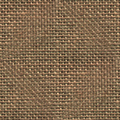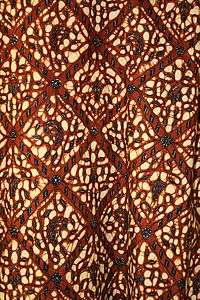Broadcloth


Broadcloth is a dense, plain woven cloth, historically made of wool. Today, most broadcloth is cotton or a cotton blend.[1] The defining characteristic of Broadcloth is not its finished width, but the fact that it was woven much wider (typically 50 - 75% wider than its finished width) and then heavily milled (traditionally the cloth was worked by heavy wooden trip hammers in hot soapy water in order to shrink it) in order to reduce it to the required width. The effect of the milling process is to draw the yarns much closer together than could be achieved in the loom and allow the individual fibres of the wool to bind together in a felting process. This results in a dense, blind, face cloth with a stiff drape which is highly weather-resistant, hard wearing and capable of taking a cut edge without the need for being hemmed.
It was made in several parts of England at the end of the medieval period. The raw material was short staple wool, carded and spun into yarn and then woven on a broad loom to produce cloth 1.75 yards wide. It was then fulled, usually in a fulling mill. When fulled, the fibres of the cloth would felt together, resulting in a smooth surface.[2]
Historical manufacture
Broadcloth (Flemish Laken) was first produced in Flanders from the 11th century and throughout the medieval period.[3]
After 1400 Leiden in Holland became the most important place for broadcloth industry in Europe. There for the first time the production became industrialised. This means that the production process didn't take place entirely in one single factory anymore but according to a precise task allocation, where in several stages intermediate goods were produced. The entire process was strictly supervised, resulting in a constantly high quality, making Leiden broadcloth very popular. In 1417 the Hanseatic League decided that only approved broadcloth from Leiden was to be sold. From 1500 competition from other parts of Europe, especially England, grew and Leiden lost its leading role.
In Italy Florence was an important center of broadcloth industry.
Around 1500, broadcloth was made in a number of districts of England, including Essex and Suffolk in southern East Anglia, the West Country Clothing District (Gloucestershire, Wiltshire, east Somerset - sometimes with adjacent areas), at Worcester, Coventry, Cranbrook in Kent and some other places.
This was the best English cloth, and large quantities were exported by the merchants of the Company of Merchant Adventurers of London, principally to Antwerp as white (i.e. undyed) cloth. It was finished and dyed in Flanders, and then marketed throughout northern Europe. The cloths might be short (24 yards long) or long (30 yards long).
The raw material for broadcloth from Worcester was wool from the Welsh border counties of Herefordshire and Shropshire, known as Lemster (i.e. Leominster) wool. That for the West Country came from the Cotswolds. In both cases, the high quality was the result of the comparatively poor pasture, which (probably aided by selective breeding) led the sheep to grow wool with the desired qualities.
English exports of broadcloth reached their highest level in the mid 16th century, after which some regions began producing other kinds of cloth, particularly various new draperies. Difficulties were encountered in export markets in the mid-1610s, partly due to currency difficulties in eastern Europe, and partly to the ill-conceived Cockayne Project. Broadcloth production thus declined in the 17th century.
Worcester remained a centre for the production of white broadcloth. Other areas, such as Ludlow and parts of the Cotswolds started to produce similar cloth, known as 'Worcesters'. The market suffered major setback in the 18th century, when the trade of the Levant Company with Turkey was obstructed by French competition. From this time, the production of broadcloth finally lost its importance.[4][5]
Types of broadcloth
Western historical terms for broadcloth include:
- bridgwater (1450-1500)[6]
- cealtar (Irish Gaelic) - thick grey broadcloth[6]
- dunster (early 14th century) - broadcloth specifically made in Somerset[6]
- Georgian cloth (c.1806)[6]
- lady's cloth - lighter weight broadcloth.[6]
- superfine (18th century onwards) - merino broadcloth used for men's tailoring.[6]
- tavestock (c.1200-1350)[6]
Modern uses
Wool broadcloth with its felted, velvet-like feel, has been a popular material for many years in furniture and luxury car interiors.
Notes
- ↑ fabric.com online fabric glossary
- ↑ The Medieval Tailor's Assistant, 63
- ↑ The Medieval Broadcloth, 2009, p. ix.
- ↑ The Woollen Industry of South-west England, 3-34
- ↑ B. Supple, Commercial crisis and change in England 1602-1642: a study in the instability of a mercantile economy (1959); J. de L. Mann, The cloth industry in the West of England (Oxford 1971).
- 1 2 3 4 5 6 7 Lewandowski, Elizabeth J. The complete costume dictionary. Lanham, Md.: Scarecrow Press, Inc. ISBN 9780810877856.
References
- Ponting, Kenneth G. (1971). The Woollen Industry of South-West England. Bath: A. M. Kelley. ISBN 0-678-07751-7.
- Thursfield, Sarah (2001). The Medieval Tailor's Assistant. New York, New York: Costume & Fashion Press. ISBN 0-89676-239-4.
- Vestergard Pedersen, Kathrine, and Nosch, Marie-Louise B. (eds) (2009). The Medieval Broadcloth: Changing Trends in Fashions, Manufacturing and Consumption. Oxford: Oxbow Books. ISBN 978-1-84217-381-7.


.svg.png)